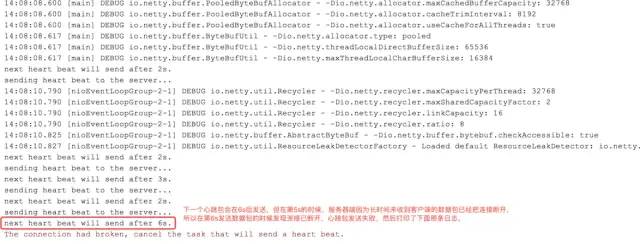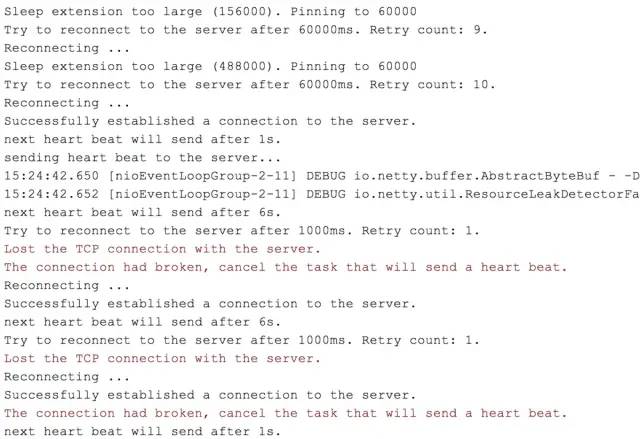服务的心跳机制与断线重连,Netty底层是怎么实现的?
点击上方蓝色“小哈学Java”,选择“设为星标”
回复“资源”获取独家整理的学习资料!
作者:sprinkle_liz
www.jianshu.com/p/1a28e48edd92
提醒:本篇适合有一定
netty基础的读者阅读
心跳机制
何为心跳
所谓心跳, 即在 TCP 长连接中, 客户端和服务器之间定期发送的一种特殊的数据包, 通知对方自己还在线, 以确保 TCP 连接的有效性.
注:心跳包还有另一个作用,经常被忽略,即:一个连接如果长时间不用,防火墙或者路由器就会断开该连接。
如何实现
核心Handler —— IdleStateHandler
在 Netty 中, 实现心跳机制的关键是 IdleStateHandler, 那么这个 Handler 如何使用呢? 先看下它的构造器:
public IdleStateHandler(int readerIdleTimeSeconds, int writerIdleTimeSeconds, int allIdleTimeSeconds) {
this((long)readerIdleTimeSeconds, (long)writerIdleTimeSeconds, (long)allIdleTimeSeconds, TimeUnit.SECONDS);
}
这里解释下三个参数的含义:
readerIdleTimeSeconds: 读超时. 即当在指定的时间间隔内没有从
Channel读取到数据时, 会触发一个READER_IDLE的IdleStateEvent事件.writerIdleTimeSeconds: 写超时. 即当在指定的时间间隔内没有数据写入到
Channel时, 会触发一个WRITER_IDLE的IdleStateEvent事件.allIdleTimeSeconds: 读/写超时. 即当在指定的时间间隔内没有读或写操作时, 会触发一个
ALL_IDLE的IdleStateEvent事件.
注:这三个参数默认的时间单位是秒。若需要指定其他时间单位,可以使用另一个构造方法:
IdleStateHandler(boolean observeOutput, long readerIdleTime, long writerIdleTime, long allIdleTime, TimeUnit unit)
在看下面的实现之前,建议先了解一下IdleStateHandler的实现原理。相关链接:
https://blog.csdn.net/linuu/article/details/51385682
下面直接上代码,需要注意的地方,会在代码中通过注释进行说明。
使用IdleStateHandler实现心跳
下面将使用IdleStateHandler来实现心跳,Client端连接到Server端后,会循环执行一个任务:随机等待几秒,然后ping一下Server端,即发送一个心跳包。当等待的时间超过规定时间,将会发送失败,以为Server端在此之前已经主动断开连接了。代码如下:
Client端
ClientIdleStateTrigger —— 心跳触发器
类ClientIdleStateTrigger也是一个Handler,只是重写了userEventTriggered方法,用于捕获IdleState.WRITER_IDLE事件(未在指定时间内向服务器发送数据),然后向Server端发送一个心跳包。
/**
*
* 用于捕获{@link IdleState#WRITER_IDLE}事件(未在指定时间内向服务器发送数据),然后向Server端发送一个心跳包。
*
*/
public class ClientIdleStateTrigger extends ChannelInboundHandlerAdapter {
public static final String HEART_BEAT = "heart beat!";
@Override
public void userEventTriggered(ChannelHandlerContext ctx, Object evt) throws Exception {
if (evt instanceof IdleStateEvent) {
IdleState state = ((IdleStateEvent) evt).state();
if (state == IdleState.WRITER_IDLE) {
// write heartbeat to server
ctx.writeAndFlush(HEART_BEAT);
}
} else {
super.userEventTriggered(ctx, evt);
}
}
}
Pinger —— 心跳发射器
/**
* 客户端连接到服务器端后,会循环执行一个任务:随机等待几秒,然后ping一下Server端,即发送一个心跳包。
*/
public class Pinger extends ChannelInboundHandlerAdapter {
private Random random = new Random();
private int baseRandom = 8;
private Channel channel;
@Override
public void channelActive(ChannelHandlerContext ctx) throws Exception {
super.channelActive(ctx);
this.channel = ctx.channel();
ping(ctx.channel());
}
private void ping(Channel channel) {
int second = Math.max(1, random.nextInt(baseRandom));
System.out.println("next heart beat will send after " + second + "s.");
ScheduledFuture future = channel.eventLoop().schedule(new Runnable() {
@Override
public void run() {
if (channel.isActive()) {
System.out.println("sending heart beat to the server...");
channel.writeAndFlush(ClientIdleStateTrigger.HEART_BEAT);
} else {
System.err.println("The connection had broken, cancel the task that will send a heart beat.");
channel.closeFuture();
throw new RuntimeException();
}
}
}, second, TimeUnit.SECONDS);
future.addListener(new GenericFutureListener() {
@Override
public void operationComplete(Future future) throws Exception {
if (future.isSuccess()) {
ping(channel);
}
}
});
}
@Override
public void exceptionCaught(ChannelHandlerContext ctx, Throwable cause) throws Exception {
// 当Channel已经断开的情况下, 仍然发送数据, 会抛异常, 该方法会被调用.
cause.printStackTrace();
ctx.close();
}
}
ClientHandlersInitializer —— 客户端处理器集合的初始化类
public class ClientHandlersInitializer extends ChannelInitializer<SocketChannel> {
private ReconnectHandler reconnectHandler;
private EchoHandler echoHandler;
public ClientHandlersInitializer(TcpClient tcpClient) {
Assert.notNull(tcpClient, "TcpClient can not be null.");
this.reconnectHandler = new ReconnectHandler(tcpClient);
this.echoHandler = new EchoHandler();
}
@Override
protected void initChannel(SocketChannel ch) throws Exception {
ChannelPipeline pipeline = ch.pipeline();
pipeline.addLast(new LengthFieldBasedFrameDecoder(Integer.MAX_VALUE, 0, 4, 0, 4));
pipeline.addLast(new LengthFieldPrepender(4));
pipeline.addLast(new StringDecoder(CharsetUtil.UTF_8));
pipeline.addLast(new StringEncoder(CharsetUtil.UTF_8));
pipeline.addLast(new Pinger());
}
}
注:上面的
Handler集合,除了Pinger,其他都是编解码器和解决粘包,可以忽略。
TcpClient —— TCP连接的客户端
public class TcpClient {
private String host;
private int port;
private Bootstrap bootstrap;
/** 将Channel保存起来, 可用于在其他非handler的地方发送数据 */
private Channel channel;
public TcpClient(String host, int port) {
this(host, port, new ExponentialBackOffRetry(1000, Integer.MAX_VALUE, 60 * 1000));
}
public TcpClient(String host, int port, RetryPolicy retryPolicy) {
this.host = host;
this.port = port;
init();
}
/**
* 向远程TCP服务器请求连接
*/
public void connect() {
synchronized (bootstrap) {
ChannelFuture future = bootstrap.connect(host, port);
this.channel = future.channel();
}
}
private void init() {
EventLoopGroup group = new NioEventLoopGroup();
// bootstrap 可重用, 只需在TcpClient实例化的时候初始化即可.
bootstrap = new Bootstrap();
bootstrap.group(group)
.channel(NioSocketChannel.class)
.handler(new ClientHandlersInitializer(TcpClient.this));
}
public static void main(String[] args) {
TcpClient tcpClient = new TcpClient("localhost", 2222);
tcpClient.connect();
}
}
Server端
ServerIdleStateTrigger —— 断连触发器
/**
* 在规定时间内未收到客户端的任何数据包, 将主动断开该连接
*/
public class ServerIdleStateTrigger extends ChannelInboundHandlerAdapter {
@Override
public void userEventTriggered(ChannelHandlerContext ctx, Object evt) throws Exception {
if (evt instanceof IdleStateEvent) {
IdleState state = ((IdleStateEvent) evt).state();
if (state == IdleState.READER_IDLE) {
// 在规定时间内没有收到客户端的上行数据, 主动断开连接
ctx.disconnect();
}
} else {
super.userEventTriggered(ctx, evt);
}
}
}
ServerBizHandler —— 服务器端的业务处理器
/**
* 收到来自客户端的数据包后, 直接在控制台打印出来.
*/
@ChannelHandler.Sharable
public class ServerBizHandler extends SimpleChannelInboundHandler<String> {
private final String REC_HEART_BEAT = "I had received the heart beat!";
@Override
protected void channelRead0(ChannelHandlerContext ctx, String data) throws Exception {
try {
System.out.println("receive data: " + data);
// ctx.writeAndFlush(REC_HEART_BEAT);
} catch (Exception e) {
e.printStackTrace();
}
}
@Override
public void channelActive(ChannelHandlerContext ctx) throws Exception {
System.out.println("Established connection with the remote client.");
// do something
ctx.fireChannelActive();
}
@Override
public void channelInactive(ChannelHandlerContext ctx) throws Exception {
System.out.println("Disconnected with the remote client.");
// do something
ctx.fireChannelInactive();
}
@Override
public void exceptionCaught(ChannelHandlerContext ctx, Throwable cause) throws Exception {
cause.printStackTrace();
ctx.close();
}
}
ServerHandlerInitializer —— 服务器端处理器集合的初始化类
/**
* 用于初始化服务器端涉及到的所有Handler
*/
public class ServerHandlerInitializer extends ChannelInitializer<SocketChannel> {
protected void initChannel(SocketChannel ch) throws Exception {
ch.pipeline().addLast("idleStateHandler", new IdleStateHandler(5, 0, 0));
ch.pipeline().addLast("idleStateTrigger", new ServerIdleStateTrigger());
ch.pipeline().addLast("frameDecoder", new LengthFieldBasedFrameDecoder(Integer.MAX_VALUE, 0, 4, 0, 4));
ch.pipeline().addLast("frameEncoder", new LengthFieldPrepender(4));
ch.pipeline().addLast("decoder", new StringDecoder());
ch.pipeline().addLast("encoder", new StringEncoder());
ch.pipeline().addLast("bizHandler", new ServerBizHandler());
}
}
注:
new IdleStateHandler(5, 0, 0)该handler代表如果在5秒内没有收到来自客户端的任何数据包(包括但不限于心跳包),将会主动断开与该客户端的连接。
TcpServer —— 服务器端
public class TcpServer {
private int port;
private ServerHandlerInitializer serverHandlerInitializer;
public TcpServer(int port) {
this.port = port;
this.serverHandlerInitializer = new ServerHandlerInitializer();
}
public void start() {
EventLoopGroup bossGroup = new NioEventLoopGroup(1);
EventLoopGroup workerGroup = new NioEventLoopGroup();
try {
ServerBootstrap bootstrap = new ServerBootstrap();
bootstrap.group(bossGroup, workerGroup)
.channel(NioServerSocketChannel.class)
.childHandler(this.serverHandlerInitializer);
// 绑定端口,开始接收进来的连接
ChannelFuture future = bootstrap.bind(port).sync();
System.out.println("Server start listen at " + port);
future.channel().closeFuture().sync();
} catch (Exception e) {
bossGroup.shutdownGracefully();
workerGroup.shutdownGracefully();
e.printStackTrace();
}
}
public static void main(String[] args) throws Exception {
int port = 2222;
new TcpServer(port).start();
}
}
至此,所有代码已经编写完毕。
测试
首先启动客户端,再启动服务器端。启动完成后,在客户端的控制台上,可以看到打印如下类似日志:

在服务器端可以看到控制台输出了类似如下的日志:

可以看到,客户端在发送4个心跳包后,第5个包因为等待时间较长,等到真正发送的时候,发现连接已断开了;而服务器端收到客户端的4个心跳数据包后,迟迟等不到下一个数据包,所以果断断开该连接。
异常情况
在测试过程中,有可能会出现如下情况:

出现这种情况的原因是:在连接已断开的情况下,仍然向服务器端发送心跳包。虽然在发送心跳包之前会使用channel.isActive()判断连接是否可用,但也有可能上一刻判断结果为可用,但下一刻发送数据包之前,连接就断了。
目前尚未找到优雅处理这种情况的方案,各位看官如果有好的解决方案,还望不吝赐教。拜谢!!!
断线重连
断线重连这里就不过多介绍,相信各位都知道是怎么回事。这里只说大致思路,然后直接上代码。
实现思路
客户端在监测到与服务器端的连接断开后,或者一开始就无法连接的情况下,使用指定的重连策略进行重连操作,直到重新建立连接或重试次数耗尽。
对于如何监测连接是否断开,则是通过重写ChannelInboundHandler#channelInactive来实现,但连接不可用,该方法会被触发,所以只需要在该方法做好重连工作即可。
代码实现
注:以下代码都是在上面心跳机制的基础上修改/添加的。
因为断线重连是客户端的工作,所以只需对客户端代码进行修改。
重试策略
RetryPolicy —— 重试策略接口
public interface RetryPolicy {
/**
* Called when an operation has failed for some reason. This method should return
* true to make another attempt.
*
* @param retryCount the number of times retried so far (0 the first time)
* @return true/false
*/
boolean allowRetry(int retryCount);
/**
* get sleep time in ms of current retry count.
*
* @param retryCount current retry count
* @return the time to sleep
*/
long getSleepTimeMs(int retryCount);
}
ExponentialBackOffRetry —— 重连策略的默认实现
/**
* Retry policy that retries a set number of times with increasing sleep time between retries
*/
public class ExponentialBackOffRetry implements RetryPolicy {
private static final int MAX_RETRIES_LIMIT = 29;
private static final int DEFAULT_MAX_SLEEP_MS = Integer.MAX_VALUE;
private final Random random = new Random();
private final long baseSleepTimeMs;
private final int maxRetries;
private final int maxSleepMs;
public ExponentialBackOffRetry(int baseSleepTimeMs, int maxRetries) {
this(baseSleepTimeMs, maxRetries, DEFAULT_MAX_SLEEP_MS);
}
public ExponentialBackOffRetry(int baseSleepTimeMs, int maxRetries, int maxSleepMs) {
this.maxRetries = maxRetries;
this.baseSleepTimeMs = baseSleepTimeMs;
this.maxSleepMs = maxSleepMs;
}
@Override
public boolean allowRetry(int retryCount) {
if (retryCount < maxRetries) {
return true;
}
return false;
}
@Override
public long getSleepTimeMs(int retryCount) {
if (retryCount < 0) {
throw new IllegalArgumentException("retries count must greater than 0.");
}
if (retryCount > MAX_RETRIES_LIMIT) {
System.out.println(String.format("maxRetries too large (%d). Pinning to %d", maxRetries, MAX_RETRIES_LIMIT));
retryCount = MAX_RETRIES_LIMIT;
}
long sleepMs = baseSleepTimeMs * Math.max(1, random.nextInt(1 << retryCount));
if (sleepMs > maxSleepMs) {
System.out.println(String.format("Sleep extension too large (%d). Pinning to %d", sleepMs, maxSleepMs));
sleepMs = maxSleepMs;
}
return sleepMs;
}
}
ReconnectHandler—— 重连处理器
@ChannelHandler.Sharable
public class ReconnectHandler extends ChannelInboundHandlerAdapter {
private int retries = 0;
private RetryPolicy retryPolicy;
private TcpClient tcpClient;
public ReconnectHandler(TcpClient tcpClient) {
this.tcpClient = tcpClient;
}
@Override
public void channelActive(ChannelHandlerContext ctx) throws Exception {
System.out.println("Successfully established a connection to the server.");
retries = 0;
ctx.fireChannelActive();
}
@Override
public void channelInactive(ChannelHandlerContext ctx) throws Exception {
if (retries == 0) {
System.err.println("Lost the TCP connection with the server.");
ctx.close();
}
boolean allowRetry = getRetryPolicy().allowRetry(retries);
if (allowRetry) {
long sleepTimeMs = getRetryPolicy().getSleepTimeMs(retries);
System.out.println(String.format("Try to reconnect to the server after %dms. Retry count: %d.", sleepTimeMs, ++retries));
final EventLoop eventLoop = ctx.channel().eventLoop();
eventLoop.schedule(() -> {
System.out.println("Reconnecting ...");
tcpClient.connect();
}, sleepTimeMs, TimeUnit.MILLISECONDS);
}
ctx.fireChannelInactive();
}
private RetryPolicy getRetryPolicy() {
if (this.retryPolicy == null) {
this.retryPolicy = tcpClient.getRetryPolicy();
}
return this.retryPolicy;
}
}
ClientHandlersInitializer
在之前的基础上,添加了重连处理器ReconnectHandler。
public class ClientHandlersInitializer extends ChannelInitializer<SocketChannel> {
private ReconnectHandler reconnectHandler;
private EchoHandler echoHandler;
public ClientHandlersInitializer(TcpClient tcpClient) {
Assert.notNull(tcpClient, "TcpClient can not be null.");
this.reconnectHandler = new ReconnectHandler(tcpClient);
this.echoHandler = new EchoHandler();
}
@Override
protected void initChannel(SocketChannel ch) throws Exception {
ChannelPipeline pipeline = ch.pipeline();
pipeline.addLast(this.reconnectHandler);
pipeline.addLast(new LengthFieldBasedFrameDecoder(Integer.MAX_VALUE, 0, 4, 0, 4));
pipeline.addLast(new LengthFieldPrepender(4));
pipeline.addLast(new StringDecoder(CharsetUtil.UTF_8));
pipeline.addLast(new StringEncoder(CharsetUtil.UTF_8));
pipeline.addLast(new Pinger());
}
}
TcpClient
在之前的基础上添加重连、重连策略的支持。
public class TcpClient {
private String host;
private int port;
private Bootstrap bootstrap;
/** 重连策略 */
private RetryPolicy retryPolicy;
/** 将Channel保存起来, 可用于在其他非handler的地方发送数据 */
private Channel channel;
public TcpClient(String host, int port) {
this(host, port, new ExponentialBackOffRetry(1000, Integer.MAX_VALUE, 60 * 1000));
}
public TcpClient(String host, int port, RetryPolicy retryPolicy) {
this.host = host;
this.port = port;
this.retryPolicy = retryPolicy;
init();
}
/**
* 向远程TCP服务器请求连接
*/
public void connect() {
synchronized (bootstrap) {
ChannelFuture future = bootstrap.connect(host, port);
future.addListener(getConnectionListener());
this.channel = future.channel();
}
}
public RetryPolicy getRetryPolicy() {
return retryPolicy;
}
private void init() {
EventLoopGroup group = new NioEventLoopGroup();
// bootstrap 可重用, 只需在TcpClient实例化的时候初始化即可.
bootstrap = new Bootstrap();
bootstrap.group(group)
.channel(NioSocketChannel.class)
.handler(new ClientHandlersInitializer(TcpClient.this));
}
private ChannelFutureListener getConnectionListener() {
return new ChannelFutureListener() {
@Override
public void operationComplete(ChannelFuture future) throws Exception {
if (!future.isSuccess()) {
future.channel().pipeline().fireChannelInactive();
}
}
};
}
public static void main(String[] args) {
TcpClient tcpClient = new TcpClient("localhost", 2222);
tcpClient.connect();
}
}
测试
在测试之前,为了避开 Connection reset by peer 异常,可以稍微修改Pinger的ping()方法,添加if (second == 5)的条件判断。如下:
private void ping(Channel channel) {
int second = Math.max(1, random.nextInt(baseRandom));
if (second == 5) {
second = 6;
}
System.out.println("next heart beat will send after " + second + "s.");
ScheduledFuture future = channel.eventLoop().schedule(new Runnable() {
@Override
public void run() {
if (channel.isActive()) {
System.out.println("sending heart beat to the server...");
channel.writeAndFlush(ClientIdleStateTrigger.HEART_BEAT);
} else {
System.err.println("The connection had broken, cancel the task that will send a heart beat.");
channel.closeFuture();
throw new RuntimeException();
}
}
}, second, TimeUnit.SECONDS);
future.addListener(new GenericFutureListener() {
@Override
public void operationComplete(Future future) throws Exception {
if (future.isSuccess()) {
ping(channel);
}
}
});
}
启动客户端
先只启动客户端,观察控制台输出,可以看到类似如下日志:

可以看到,当客户端发现无法连接到服务器端,所以一直尝试重连。随着重试次数增加,重试时间间隔越大,但又不想无限增大下去,所以需要定一个阈值,比如60s。如上图所示,当下一次重试时间超过60s时,会打印Sleep extension too large(*). Pinning to 60000,单位为ms。出现这句话的意思是,计算出来的时间超过阈值(60s),所以把真正睡眠的时间重置为阈值(60s)。
启动服务器端
接着启动服务器端,然后继续观察客户端控制台输出。

可以看到,在第9次重试失败后,第10次重试之前,启动的服务器,所以第10次重连的结果为Successfully established a connection to the server.,即成功连接到服务器。接下来因为还是不定时ping服务器,所以出现断线重连、断线重连的循环。
扩展
在不同环境,可能会有不同的重连需求。有不同的重连需求的,只需自己实现RetryPolicy接口,然后在创建TcpClient的时候覆盖默认的重连策略即可。
完!!!
END
有热门推荐👇
最近面试BAT,整理一份面试资料《Java面试BATJ通关手册》,覆盖了Java核心技术、JVM、Java并发、SSM、微服务、数据库、数据结构等等。
获取方式:点“在看”,关注公众号并回复 Java 领取,更多内容陆续奉上。
文章有帮助的话,在看,转发吧。
谢谢支持哟 (*^__^*)


